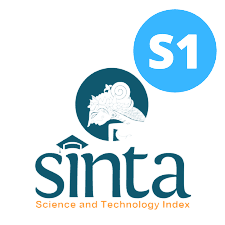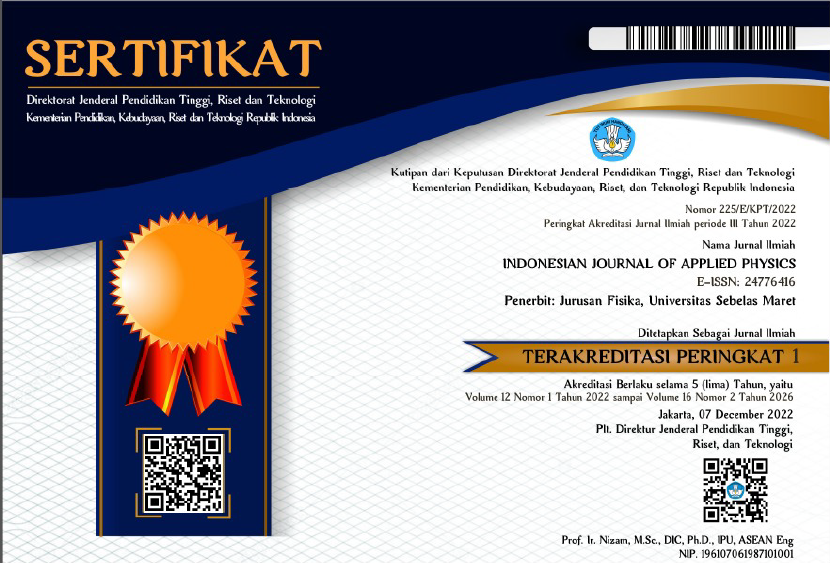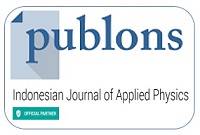Modified household pressure cookers as Hydrothermal Reactor for Production of Carbon Dots from Fish Scale Waste
Abstract
Recent advancements in the synthesis of carbon dots utilizing basic equipment are crucial for their large-scale production. This study explores the use of household pressure cookers to synthesize carbon dots from fish waste. A thermocouple and manometer are integrated into the cooker to regulate temperature and monitor pressure. Optimization of the equipment reveals that heating 2000 mL of distilled water to 100°C requires 20, 30, and 32 minutes with power inputs of 800 W, 700 W, and 600 W, respectively. The modified cooker achieves optimal pressure and temperature at 2.4 bars, 1.7 bars, and 1.5 bars, and 136°C, 123°C, and 122°C after 60 minutes of heating with the same power inputs. These results demonstrate that a household pressure cooker can effectively synthesize carbon dots. Experiments using dried Red Snapper fish spray powder, both unground and ground, at 800 W, 700 W, and 600 W, reach optimal pressure of 2.4 bar in 36, 49, and 58 minutes, and temperatures of 128°C, 131°C, and 136°C. Carbon dots are synthesized from fish scales as fine fibers with a 1:5 weight ratio of scales to distilled water, employing 600 W power, 2.4 bar pressure, 136°C temperature, 58 minutes of boiling, 5 minutes of centrifugation at 3500 rpm, and 45 minutes of ultrasound at 42 kHz. The formation of carbon dots is confirmed by an absorption peak at 405 nm in the UV-Vis spectrum, indicating high absorbance and bright blue fluorescence. Further investigation is required to optimize equipment using various fish scales and purification processes
Keywords
Full Text:
PDFReferences
1 Campalani, C., Cattaruzza, E., Zorzi, S., Vomiero, A., You, S., Matthews, L., Capron, M., Mondelli, C., Selva, M., & Perosa, A. 2021. Biobased Carbon Dots: From Fish Scales to Photocatalysis. Nanomaterials, 11(2), 524.
2 Qin, D., Bi, S., You, X., Wang, M., Cong, X., Yuan, C., Yu, M., Cheng, X., & Chen, X.-G. 2022. Development and application of fish scale wastes as versatile natural biomaterials. Chemical Engineering Journal, 428, 131102.
3 Silva, A. V. S., Torquato, L. D. M., & Cruz, G. 2019. Potential application of fish scales as feedstock in thermochemical processes for the clean energy generation. Waste Management, 100, 91–100.
4 Zhang, Y., Lei, C., Dong, P., Fu, P., Zhang, Y., & Hua, R. 2024. Green synthesis of carbon dots from fish scales for selective turn off–on detection of glutathione. RSC Advances, 14(5), 3578–3587.
5 Zhang, Y., Gao, Z., Zhang, W., Wang, W., Chang, J., & Kai, J. 2018. Fluorescent carbon dots as nanoprobe for determination of lidocaine hydrochloride. Sensors and Actuators B: Chemical, 262, 928–937.
6 Ashraf, P. M., Stephen, S., & Binsi, P. K. 2021. Sustainable process to co-synthesize nano carbon dots, nano hydroxyapatite and nano β-dicalcium diphosphate from the fish scale. Applied Nanoscience, 11(6), 1929–1947.
7 Balou, S., Shandilya, P., & Priye, A. 2022. Carbon dots for photothermal applications. Frontiers in Chemistry, 10.
8 Ullal, N., Muthamma, K., & Sunil, D. 2022. Carbon dots from eco-friendly precursors for optical sensing application: an up-to-date review. Chemical Papers, 76(10), 6097–6127.
9 Dhandapani, E., Duraisamy, N., & Periasamy, P. 2021. Highly green fluorescent carbon quantum dots synthesis via hydrothermal method from fish scale. Materials Today: Proceedings.
10 Athinarayanan, J., Periasamy, V. S., & Alshatwi, A. A. 2020. Simultaneous fabrication of carbon nanodots and hydroxyapatite nanoparticles from fish scale for biomedical applications. Materials Science and Engineering: C, 117, 111313.
11 Zhang, Y., Gao, Z., Yang, X., Chang, J., Liu, Z., & Jiang, K. 2019. Fish-scale-derived carbon dots as efficient fluorescent nanoprobes for detection of ferric ions. RSC Advances, 9(2), 940–949.
12 Yao, Q. F., Zhou, D. S., Yang, J. H., & Huang, W. T. 2020. Directly reusing waste fish scales for facile, large-scale and green extraction of fluorescent carbon nanoparticles and their application in sensing of ferric ions. Sustainable Chemistry and Pharmacy, 17, 100305.
13 Dehvari, K., Liu, K. Y., Tseng, P.-J., Gedda, G., Girma, W. M., & Chang, J.-Y. 2019. Sonochemical-assisted green synthesis of nitrogen-doped carbon dots from crab shell as targeted nanoprobes for cell imaging. Journal of the Taiwan Institute of Chemical Engineers, 95, 495–503.
14 Laber, C. H., Essner, J. B., Scott, T. A., Polo-Parada, L., & Baker, G. A. (2016). Domestic pressure cooker as inexpensive hydrothermal vessel: Demonstrated utility for eco-friendly synthesis of non-toxic carbon dots. Nano-Structures & Nano-Objects, 6, 52–58.
15 Kora, A. J. 2023. A domestic pressure cooker mediated, facile autoclaving method for the synthesis of silver nanoparticles. MethodsX, 11, 102438.
16 Pandara, Dolfie P, Masengi, K. W. A., Tamuntuan, G. H., Angmalisang, P. A., Wuntu, A. D., Ferdy, F., Bobanto, M. D., & Sompotan, A. F. 2022. The potential of fish scale application as photothermal raw material in seawater desalination. Aquaculture, Aquarium, Conservation & Legislation, 15(4), 1617–1629.
17 Rumengan, I. F. M., Suptijah, P., Wullur, S., & Talumepa, A. 2017. Characterization of chitin extracted from fish scales of marine fish species purchased from local markets in North Sulawesi, Indonesia. IOP Conf. Series: Earth and Environmental Science, 1315–1755.
18 Al-Attar, A., & Harrison, O. 2023. Physics of gases. Anaesthesia & Intensive Care Medicine.
19 Huang, Z., & Ren, L. 2025. Large Scale Synthesis of Carbon Dots and Their Applications: A Review. Molecules, 30(4), 774.
Refbacks
- There are currently no refbacks.
















